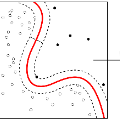
Security research has concentrated on converting operating system audit logs into suitable graphs, such as provenance graphs, for analysis. However, provenance graphs can grow very large requiring significant computational resources beyond what is necessary for many security tasks and are not feasible for resource constrained environments, such as edge devices. To address this problem, we present the \textit{resource-interaction graph} that is built directly from the audit log. We show that the resource-interaction graph's storage requirements are significantly lower than provenance graphs using an open-source data set with two container escape attacks captured from an edge device. We use a graph autoencoder and graph clustering technique to evaluate the representation for an anomaly detection task. Both approaches are unsupervised and are thus suitable for detecting zero-day attacks. The approaches can achieve f1 scores typically over 80\% and in some cases over 90\% for the selected data set and attacks.
翻译:安全研究的重点是将操作系统审计日志转换成适当的图表,如出处图,以供分析。然而,出处图可以大幅增长,需要大量计算资源,超过许多安全任务所需的数量,对资源受限的环境(例如边缘装置)来说不可行。为了解决这个问题,我们展示直接从审计日志中创建的\textit{resources-interactal 图表}。我们用一个有两枚从边缘设备中捕获的集装箱逃脱攻击的公开源数据组,显示资源互动图的存储要求大大低于出处图。我们使用一个图形自动编码器和图形组合技术来评估异常探测任务的表现。这两种方法都不受监督,因此适合探测零日攻击。这种方法可以达到f1分数,通常超过80 ⁇,有时超过90 ⁇,用于选定的数据集和攻击。


